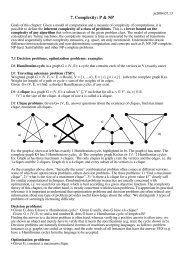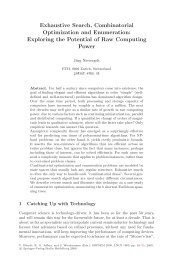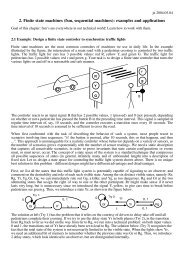8. Equivalence of TMs, PMs and Markov algorithms - Jn.inf.ethz.ch
8. Equivalence of TMs, PMs and Markov algorithms - Jn.inf.ethz.ch
8. Equivalence of TMs, PMs and Markov algorithms - Jn.inf.ethz.ch
Create successful ePaper yourself
Turn your PDF publications into a flip-book with our unique Google optimized e-Paper software.
M’s configuration: state q, tape < B y x z C > is modeled asP’s configuration: state q, tape x z C > < B yThis encoding is practically forced, since P must inspect the same symbol x as M does, but the only symbol it caninspect is at the head <strong>of</strong> the queue. As M executes a transition q, x -> q’ x’ R or q, x -> q’ x’ L , P must beprogramed to transform its queue in a corresponfding manner. First try, whi<strong>ch</strong> doesn’t quite work.The easy case, a move-right transition q, x -> q’ x’ R :M: q, < B y x z C > becomes q’, < B y x’ z C >P: q, x z C > < B y becomes q’, z C > < B y x’A single P transition a<strong>ch</strong>ieves precisely the required tranformation.The cumbersome case, a move-left transition q, x -> q’ x’ L :M: q, < B y x z C > becomes q’, < B y x’ z C >P: q, x z C > < B y must become q’, y x’ z C > < BP’s transformation requires a complete rotation <strong>of</strong> the queue in order to bring the tail symbol to the head <strong>of</strong> thequeue. A rotation is possible if there is a distinguished symbol # that tells us when to stop. Thus, the tentativeencoding used so far fails for a move-left transition <strong>and</strong> must be corrected.Correct encoding <strong>of</strong> M’s configuration in P’s configuration: place a marker # two slots to the left <strong>of</strong> the scannedsymbol x. “To the left” is interpreted in a circular way, as if head <strong>and</strong> tail were glued together, <strong>and</strong> hence # appearsas the next-to-last symbol in the queue.M’s configuration: state q, tape < B y x z C > is modeled asP’s configuration: state q, tape x z C > < B # ySimulating a move-right transition q, x -> q’ x’ R :M: q, < B y x z C > becomes q’, < B y x’ z C >P: q, x z C > < B # y becomes q’, z C > < B y # x’Unfornately, this former “easy case” has become more complicated, since the consecutive pair # y must bepermuted to y #. This can be a<strong>ch</strong>ieved using auxiliary states <strong>and</strong> a complete rotation.Simulating a move-left transition q, x -> q’ x’ L,focus on the two neighboring symbols to the left <strong>of</strong> the scanned symbol x:M: q, < B y z x C > becomes q’, < B y z x’ C >P: q, x C > < B y # z becomes q’, z x’ C > < B # yAgain, the consecutive pair # y must be permuted to y #, a<strong>ch</strong>ieved using auxiliary states <strong>and</strong> a complete rotation.Two more cases must be considered, when M’s read/write head is positioned at either end <strong>of</strong> the tape visited so far,on a symbol < or >, <strong>and</strong> possibly extends the visited portion. In summary, the design <strong>of</strong> a PM that simulates anarbitrary TM is conceptually straightforward once one has mastered the acrobatics <strong>of</strong> P’s queue rotations.Thus, we have completed the cycle TM ≥ MA ≥ PM ≥ TM that proves the computational equivalence <strong>of</strong> thesethree universal models <strong>of</strong> computation.Reference: Solvability, Provability, Definability: The Collected Works <strong>of</strong> Emil L. Post, Martin Davis (ed.),Birkhaeuser 1994. (Includes the article “Emil L. Post: His Life <strong>and</strong> Work”)Homework: For ea<strong>ch</strong> <strong>of</strong> the following problems, design a <strong>Markov</strong> algorithm (MA), a Post ma<strong>ch</strong>ine (PM), <strong>and</strong> aTuring ma<strong>ch</strong>ine (TM). You are free to <strong>ch</strong>oose the detailed conventions <strong>of</strong> these ma<strong>ch</strong>ines, as well as the coding <strong>of</strong>the input <strong>and</strong> output, as long as you explain precisely what conventions you are using.1) Given a natural number k > 0 in unary notation, i.e. as 1 k , produce the output a k b k .Example <strong>of</strong> possible input/output coding:MA: initial data string 1 1 ... 1; final string a a ... a b b ... bPM: initial queue content 1 1 ... 1 #; final content a a ... a b b ... b #TM: initial tape content # 1 1 ... 1 --- with the read/write head positioned on #, the tape extending to the right;







![CV [PDF]](https://img.yumpu.com/5256601/1/184x260/cv-pdf.jpg?quality=85)